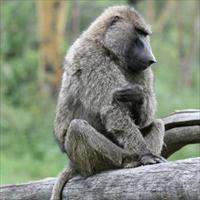KENYA: Wild animals compete with humans for scarce water resources

"I killed a baboon after they tried to force me
from the 'lagadera' [stream in Somali]," he said, holding out his bandaged
arm. "They were thirsty and wanted water just like my goats. The well is
the only one with water."
At another well, four girls abandoned their water
containers after thirsty baboons attacked them. The next day, five goats were
killed by the creatures while two herders sustained serious injuries following
an attack by a lion.
A month after the rains were expected to start, northern
Kenya
is still gripped by drought conditions. Water pans, boreholes and wells have
all dried up, creating problems for the pastoralist communities of the region.
"We are in the middle of a very serious
crisis," said Hussein Ali from Sericho, a remote trading centre along the
Isiolo and Garissa district boarder. "We are faced with the problem of
water, pasture and now wild animals have worsened our situation."
Like domestic livestock, the wild animals have also been
affected by scarcity of water. Local residents of Isiolo and Garissa say the
situation has forced the animals to struggle for the little available water
with humans.
At least 20 people, they say, have sustained injuries in
the past month from animal attacks, while one pastoralist and a number of
livestock have been killed by lions at wells.
Apart from protecting water wells, Ali said, local
people in the affected areas had also resorted to killing the animals whenever
they could catch them.
"Girls and women who were entrusted with fetching
water have also been advised not to visit the wells alone," he added.
Yussuf Dogo from the Friends Of Nomads International
organisation said some residents had sought water and pasture in nearby
protected game reserves.
The area, which suffered a severe drought two years ago,
is expected to receive some rain soon. According to the Famine
Early Warning Systems Network (FEWS Net), moderate amounts of rainfall are
expected to alleviate the long-term dryness that has affected many areas of
northern Kenya.
In a 10-16 April assessment, FEWS Net said significantly
below-normal October-December rain had led to reduced crop yields, poor pasture
and insufficient water resources in parts of Kenya, as well as poor soil
conditions.
 Back and Next - Back and Next
Back and Next - Back and Next See Also - See Also
See Also - See Also